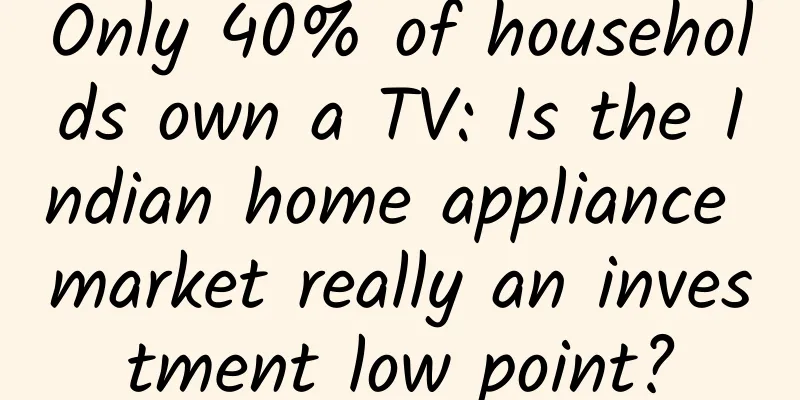Only 40% of households own a TV: Is the Indian home appliance market really an investment low point?

|
Indians say that if they don't speed up development, Shanghai will surpass Mumbai. The impression of India by the general Chinese people is mostly crowded trains, horrible slums and singing and dancing Indian movies. The people of the two countries absolutely do not recognize each other's impressions. This also shows that there are not enough people-to-people exchanges between the two countries, and there is a lack of sufficient understanding between each other. They are still stuck in the impressions of many years ago. It is time to refresh our cognition and deepen our understanding. We are no longer what we used to be. Recently, a reporter from China Home Appliance Network followed the Indian research team of the Electric Water Heater Special Committee of the China Home Appliance Association to conduct a field investigation of the Indian home appliance market. From Mumbai to Delhi, from manufacturers to channels, from overseas institutions to local chambers of commerce, we can see what India means to Chinese home appliance companies today. Is the elephant dancing? In terms of land area, India is the seventh largest country in the world, and its population is comparable to that of China. According to IMF data, India's GDP in 2016 was US$2256.3 billion, ranking seventh in the world. India has become the fastest growing economy in the world for the first time. In May 2014, Modi became the 15th Prime Minister of India. As a "pragmatist", Modi has implemented a series of reforms to promote India's economic development after taking office. For example, streamlining government agencies and promoting electronic government affairs have greatly improved administrative efficiency; the implementation of the Product and Service Tax (GST) in April 2017 unified India's tax system, reduced transaction costs, and was conducive to the circulation of various production factors and the integration of the Indian market; increased investment in infrastructure construction, especially in the fields of electricity and transportation; further opened up the fields and shareholding ratios of foreign investment, and some fields have allowed 100% foreign investment, enhancing the attractiveness to foreign investment. Indian Prime Minister Modi Earlier this year, foreign media reported that New Delhi announced economic data for the third quarter of fiscal year 2017, reaching an annualized GDP growth rate of 7.2%, which exceeded the level of China in the same period. Regardless of the accuracy of the statistics, India's economy has indeed developed faster than in the past. India's changes have also been recognized by investors. Song Yujun, vice president of Haier Home Appliances Industry Group and director of South Asia, believes that India has changed a lot in recent years. The Modi government has made great efforts to attract investment, the investment environment is also improving, and the infrastructure is also improving, and the investment prospects are optimistic. Home appliance consumption is starting. According to data provided by the India China Cultural and Economic Promotion Association (ICEC), only 40% of Indian households own televisions, 29% of households own refrigerators, 11% of households own washing machines, 6% of households own computers or laptops, and less than 4% of households own air conditioners. In 2017, the overall size of the durable consumer goods market (including home appliances and consumer electronics, excluding mobile phones) was 1 trillion rupees (about US$15.5 billion). From the perspective of product structure, the Indian home appliance market has its regional characteristics. In India's home appliance chain stores, there are window air conditioners, single-door refrigerators, double-cylinder washing machines, as well as variable-frequency split air conditioners, double-door luxury refrigerators, and large-capacity drum washing machines. The product prices range from 8,000 rupees to 300,000 rupees. Due to the large income gap in Indian society, and most of the households are middle- and low-income (about 80% of Indian households have an annual income of less than $4,000), although there are high, medium and low-end products, low- and medium-end products account for more than 70% of the market share. From the perspective of sales channels, e-commerce platforms such as Amazon and Flipkart have seen rapid growth in sales, with a share of between 6% and 10%, while offline channels are still the mainstream. According to staff from the India China Friendhip Association, traditional agency distribution channels account for about 60% of offline channels, direct retailers account for 30%, and chain channels account for 10%. In the Indian market, consumers' priority in purchasing home appliances and electronic products is mobile phones, televisions, refrigerators, washing machines, air conditioners, etc. Xiaomi mobile phones at CROMA store in Mumbai At present, the dominant position in the Indian home appliance market is mainly non-Indian foreign-funded enterprises, such as LG, Samsung, Whirlpool, Siemens, etc. in the field of white goods, Samsung, LG, Panasonic and Sony, etc. in the field of consumer electronics such as televisions, and Samsung, Apple, Xiaomi, VIVO & OPPO, etc. in the field of mobile phones. CROMA store in Mumbai, India The huge potential of the Indian market has also attracted investment from Chinese home appliance companies. As early as 2002, Haier began to try to enter the Indian market. After more than ten years of operation, through localized design, localized manufacturing, and localized services, Haier has now achieved localized operations in the Indian market, gradually expanding its market share and significantly improving its brand awareness. Song Yujun revealed that in the research report of Trust Research Advisory (TRA), an authoritative consulting and research company in India, Haier ranked 19th on the list of "Top 50 Most Trusted Brands by Indians". In 2018, Haier India's sales will reach US$500 million. Haier Store in New Delhi In November 2017, the Haier Industrial Park in Pune, India, was put into production. The product categories produced by Haier's local factories will expand from refrigerators to washing machines, air conditioners, water heaters, TVs, etc. Midea also attaches great importance to the expansion of the Indian home appliance market. In February 2012, Midea and Carrier established a joint venture in India to localize the manufacturing of air conditioners. By leasing a factory in Rewari for renovation, the company started production in October of that year and expanded its product categories from air conditioners to washing machines and water purifiers in 2016. According to Hu Jianguo, head of Carrier Midea's Indian joint venture CMI, Midea has established a sales and service network covering four major regions in India. Air conditioner sales in 2017 increased by 14% year-on-year, and sales growth in 2018 is expected to exceed 20%. CMI Factory Visit Hu Jianguo said that the senior management of Midea Group attaches great importance to the Indian market and regards India as a key market in Midea's global development strategy, which may become an important production center in the future. It is understood that Midea's Pune factory, which has invested 8 billion rupees, will be put into production at the end of 2018. The new factory will be used to produce refrigerators, washing machines, water appliances and other products. Risks and Opportunities According to the IMF forecast, India's economy is expected to maintain a growth rate of more than 7% until 2020. According to data from the India China Cultural and Economic Promotion Council (ICEC), the market size of durable consumer goods in India will reach 3 trillion rupees (about 46.5 billion US dollars) by 2020. Another statistical data shows that the proportion of people under 35 in India exceeds 60%, which also means that India has abundant labor resources. There is not only a continuously and steadily growing market demand, but also a large supply of cheap labor, a high penetration rate of English, and a good location advantage. These resources or advantages indicate that India has the capital and potential to become the world's factory. According to the calculation data of relevant institutions, in 2016, India's manufacturing output contributed about 17% to GDP, which is far lower than China's level. Indian Prime Minister Modi proposed the "Make in India" development strategy when he came to power, hoping to learn from China's experience to promote the expansion of India's manufacturing industry. In order to encourage more foreign investment to invest and build factories in India, the Indian government has also made many adjustments in trade policies, significantly increasing import tariffs on electronic and home appliances. Take mobile phone imports as an example. Since July 1, 2017, according to the new GST tax system, the import of complete machines needs to pay a 10% tariff. By December 2017, India raised the import tariff from 10% to 15%. In early February 2018, India announced again that it would increase the import tariff on mobile phones to 20%. On the one hand, India is protecting domestic manufacturing, and on the other hand, it is also "forcing" foreign companies to directly invest and build factories in India. According to a notice issued by the Indian government in early April this year, India has begun to impose a 10% tariff on core smartphone components such as printed circuit boards (PCBs), camera modules and connectors. Through the adjustment of tariff policies, India will not only "attract" complete machine companies to invest and build factories in India, but also "drive" component companies to build factories in India. According to Indian trade insiders, similar policy measures will also be applied to manufacturing industries such as home appliances. If Chinese companies want to share the cake of the Indian home appliance market, investing and building factories in India seems to be a must. According to business people who have invested in India for many years, India's laws are very sound and complex, and they need to guard against "risks" in this regard. For example, India currently has more than 50 central labor laws and more than 170 local labor laws, and these labor laws are very strict in protecting workers. The "Labor Dispute Law" promulgated in 1947 stipulates that companies with more than 100 employees must obtain government approval when laying off employees. The "Labor Contract Law" promulgated in 1970 stipulates that companies with more than 20 employees must obtain government approval before hiring contract workers. In addition, India's trade unions are also very powerful, and local government bureaucrats are corrupt. These are important factors that companies need to consider and evaluate before investing. The Indian head of the Indian branch of a Chinese mobile phone brand told the visiting Chinese companies that the Indian market is a price-oriented market, and users pursue cost-effectiveness. He also emphasized that any strategy in India must consider a long-term plan. Xu Dongsheng, vice director of the China Home Appliance Association, believes that India's current level of development is equivalent to that of China more than 20 years ago, and Chinese home appliance companies have great potential to share their development experience in India. The Gateway of India (also known as the Welcome Gate) is one of India's iconic buildings, with the tranquil Arabian Sea on one side and the bustling city of Mumbai on the other. This relationship is also true for Mumbai and even India. Mumbai is the capital of India's business and entertainment industry, attracting immigrants and wealthy people from all over India. Here is Antilia, the $1 billion mansion of India's richest man Mukesh Ambani, and next to the mansion is Dharavi, Asia's largest slum; here there is a poor and dirty side, as well as a high-end side; here there is heaven on one side and hell on the other. For companies that want to invest in the Indian home appliance market, there are huge opportunities on one side and greater challenges on the other. As a winner of Toutiao's Qingyun Plan and Baijiahao's Bai+ Plan, the 2019 Baidu Digital Author of the Year, the Baijiahao's Most Popular Author in the Technology Field, the 2019 Sogou Technology and Culture Author, and the 2021 Baijiahao Quarterly Influential Creator, he has won many awards, including the 2013 Sohu Best Industry Media Person, the 2015 China New Media Entrepreneurship Competition Beijing Third Place, the 2015 Guangmang Experience Award, the 2015 China New Media Entrepreneurship Competition Finals Third Place, and the 2018 Baidu Dynamic Annual Powerful Celebrity. |
>>: Tesla Model Y, BYD Tang EV and Arcfox Alpha T: Which pure electric long-range SUV is better?
Recommend
Tik Tok promotion strategy, how to come up with a Tik Tok title?
Tik Tok is a popular product. Many individuals, t...
The catkins are coming! Please keep this guide to catkin protection during the catkin season
With the rising temperature in the past few days ...
What does the newly recorded orchid in Qinghai look like?
Loading long image... Producer: Ma Lian Editor: W...
Tesla Autopilot may cause another accident with minor injuries to the occupants
According to foreign media reports, a Tesla model...
up to date! Data rankings of 59 information flow advertising platforms!
The following is the latest traffic ranking of 59...
South Korea's Ministry of Land, Infrastructure and Transport: South Korea's new energy vehicle ownership exceeds 1 million
Data released by the Ministry of Land, Infrastruc...
Apple products to watch in 2024: iPhone 16, Apple Intelligence, and other expected "Glowtime" releases
Apple will launch the iPhone 16 at its "It&#...
Exploring the potential and challenges of developing games for Apple Watch
The developers of the first Apple Watch game are ...
Internet people among the two sessions representatives
The annual "two sessions" (referring to...
Refined operation strategy for social marketing!
The induced sharing in Moments has been banned fo...
How did Qingtuan become associated with Qingming Festival?
The following article comes from Bowu, author Bug...
SwiftUI Advanced Animation Canvas
Preface This fifth installment of our Advanced Sw...
Super data recovery money-making project, easily earn 10,000+ per month (with tutorial data recovery software cracked version collection)
I believe everyone has the experience of accident...
How did the ancients see Mars?
Author: Fan Yu (Lunar and Deep Space Exploration ...
How to write a standard event copy?
In an event, you need to use event copy to clearl...









